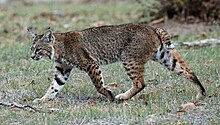
The jaguar is a large cat species and the only living member of the genus Panthera native to the Americas. With a body length of up to 1.85 m and a weight of up to 158 kg (348 lb), it is the largest cat species in the Americas and the third largest in the world. Its distinctively marked coat features pale yellow to tan colored fur covered by spots that transition to rosettes on the sides, although a melanistic black coat appears in some individuals. The jaguar's powerful bite allows it to pierce the carapaces of turtles and tortoises, and to employ an unusual killing method: it bites directly through the skull of mammalian prey between the ears to deliver a fatal blow to the brain.

The cougar is a large cat native to the Americas. Its range spans from the Canadian Yukon to the southern Andes in South America and is the most widespread of any large wild terrestrial mammal in the Western Hemisphere. It is an adaptable, generalist species, occurring in most American habitat types. This wide range has brought it many common names, including puma, mountain lion, catamount and panther. It is the second-largest cat in the New World, after the jaguar. Secretive and largely solitary by nature, the cougar is properly considered both nocturnal and crepuscular, although daytime sightings do occur. Despite its size, the cougar is more closely related to smaller felines, including the domestic cat, than to any species of the subfamily Pantherinae.
The term "big cat" is typically used to refer to any of the five living members of the genus Panthera, namely the tiger, lion, jaguar, leopard, and snow leopard, as well as the non-pantherine cheetah and cougar.

The ocelot is a medium-sized spotted wild cat that reaches 40–50 cm (15.7–19.7 in) at the shoulders and weighs between 7 and 15.5 kg on average. It was first described by Carl Linnaeus in 1758. Two subspecies are recognized. It is native to the southwestern United States, Mexico, Central and South America, and the Caribbean islands of Trinidad and Margarita. It prefers areas close to water sources with dense vegetation cover and high prey availability.
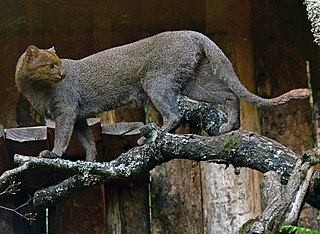
The jaguarundi is a wild cat native to the Americas. Its range extends from central Argentina in the south to northern Mexico, through Central and South America east of the Andes. The jaguarundi is a medium-sized cat of slender build. Its coloration is uniform with two color morphs, gray and red. It has an elongated body, with relatively short legs, a small, narrow head, small, round ears, a short snout, and a long tail, resembling mustelids in these respects. It is about twice as large as a domestic cat, reaching nearly 360 mm (14 in) at the shoulder, and weighs 3.5–7 kg (7.7–15.4 lb).
A purr is a tonal fluttering sound made by some species of felids, including both larger, outdoor cats and the domestic cat, as well as two species of genets. It varies in loudness and tone among species and in the same animal.
A Society for the Prevention of Cruelty to Animals (SPCA) is a common name for non-profit animal welfare organizations around the world. The oldest SPCA organization is the RSPCA, which was founded in England in 1824. SPCA organizations operate independently of each other and campaign for animal welfare, assist in the prevention of cruelty to animals cases.
In Mexican folklore, the onza is a legendary cat species.

A felid hybrid is any of a number of hybrids between various species of the cat family, Felidae. This article deals with hybrids between the species of the subfamily Felinae.

The North American cougar is a cougar subspecies in North America. It is the biggest cat in North America, with North American jaguars being fairly small. It was once common in eastern North America, and is still prevalent in the western half of the continent. This subspecies includes populations in western Canada, the western United States, Florida, Mexico and Central America, and possibly South America northwest of the Andes Mountains. It thus includes the extirpated Eastern cougar and extant Florida panther populations.

A rosette is a rose-like marking or formation found on the fur and skin of some animals, particularly cats. Rosettes are used to camouflage the animal, either as a defense mechanism or as a stalking tool. Predators use their rosettes to simulate the different shifting of shadows and shade, helping the animals to remain hidden from their prey. Rosettes can be grouped in clusters around other spots, or may appear as blotches on the fur.
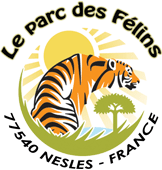
Parc des Félins is a zoological park in France dedicated to the breeding and conservation of wild members of the cat family. It is located in the commune of Lumigny-Nesles-Ormeaux in Seine-et-Marne, about 53.6 km (33.3 mi) southeast of Paris.

The southern brown howler is a monkey subspecies of brown howler native to southeastern Brazil and far northeastern Argentina (Misiones). Gregorin, 2006, considered the southern brown howler to be a separate species, Alouatta clamitans, but this has not been universally accepted.

Panthera Corporation, or Panthera, is a charitable organization devoted to preserving wild cats and their ecosystems around the globe. Founded in 2006, Panthera is devoted to the conservation of the world’s 40 species of wild cats and the vast ecosystems they inhabit. Their team of biologists, data scientists, law enforcement experts and wild cat advocates studies and protects the seven species of big cats: cheetahs, jaguars, leopards, lions, pumas, snow leopards and tigers. Panthera also creates targeted conservation strategies for the world’s most threatened and overlooked small cats, such as fishing cats, ocelots and Andean cats. The organization has offices in New York City and Europe, as well as offices in Mesoamerica, South America, Africa and Asia.
Cytauxzoon is a genus of parasitic alveolates in the phylum Apicomplexa. The name is derived from the Greek meaning an increase in the number of cells in an animal.
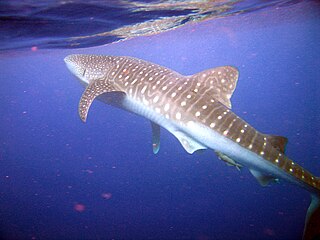
The flora and fauna of Honduras reflects the country's geographical location inside the tropics. This has allowed for diverse species of plants and animals to be adapted, but some of them are now in danger of extinction. This has posed the Honduran government, offices and nature organizations to look after the protection of the local environment, like the creation of nature reserves.
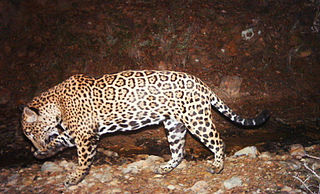
The North American jaguar is a jaguar population in North America, ranging from the Southwestern United States to Central America. They are most associated to Central and South America. This population has declined over decades and was almost extirpated from the United States by 1960.

The Veracruz montane forests is a tropical moist broadleaf forest ecoregion in eastern Mexico. It includes a belt of montane tropical forest on the eastern slope of the southern Sierra Madre Oriental and eastern Trans-Mexican Volcanic Belt ranges. These forests lie between the lowland Veracruz moist forests and the pine-oak forests of the higher mountains.

